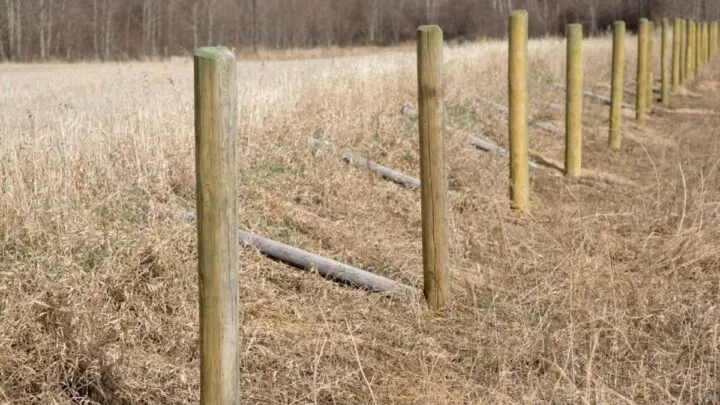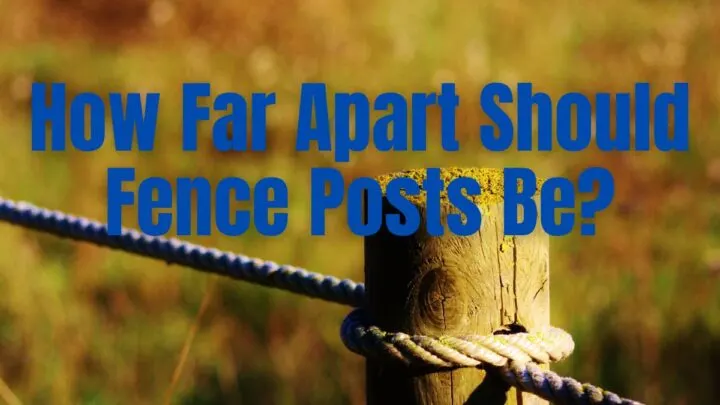Deciding how far apart your fence posts should be will depend on a number of factors that you need to consider before you start digging.
Fences are great ways to keep things in or keep other things out, but they can be time-consuming to build as well as expensive, depending on the materials you use.
Adding to that expense by buying more fence posts than you need is not ideal. On the other hand, if you don’t use enough posts, your fence will sag and be ineffective.
Your fence posts should be anywhere from 8 feet to 30 feet apart, depending on whether you are installing the fence posts to support a wood rail fence, a barbed-wire fence, or a deer and wildlife fence.
It may seem odd that fences have such different rules of thumb when it comes to fence post-installation, but it really does make a difference. No one wants to spend the time and money to install a fence to then have it not serve its purpose or worse, be dangerous.
Knowing why and when to place fence posts at a certain distance from each other will be imperative for your fence to fully function.
Let’s do a deeper dive into fence post placement to ensure your experience is a positive one.

How Far Apart Should Fence Posts Be?
Fence posts can be made from a variety of different materials, but the most common ones are made of weather-treated wood, steel or iron. What type of material you use and how far apart you will place the posts will have a lot to do with what type of fence you intend to install and the purpose of the fence.
1. Posts for a Wood Rail Fence
A standard, wood slat fence is one of the most common. They are used for horse pastures, farms, property boundaries, and sometimes just for the aesthetics, as they tend to be very attractive and add beauty to your property as well as functionality.
But with that beauty comes a price. These fences can be quite expensive, especially if you choose to have the standard 3-rail or anything more.
This is a good reason to be intentional when placing your fence posts for a wood rail fence. If you overdo it, you will not only be adding to your workload, but your cost as well.
For a wood rail fence, plan on placing your fence posts approximately 8 to 12 feet apart. This will allow for your boards to be just long enough to serve their purpose, without sagging or weakening because of their length.
If you are using this type of fencing for horses, donkeys, mules, or other such equines, remember that these animals like to chew. So, if you are going to have to replace fence rails, it may be a good idea to place your fence posts a bit closer together so you don’t have to replace a fence board that is super long.
2. Posts for a Barbed Wire Fence
Barbed wire is not always the most attractive fencing option, but may be necessary for your needs.
Barbed wire is typically used for cattle or other stubborn types of livestock. It is not the best fencing to have around young children or pets, but it is extremely effective at keeping those animals inside an enclosure who definitely have a mind of their own and the weight to throw behind it.
Most of the posts that accompany a barbed-wire fence are made from metal – though you’ll often see the “anchor” posts made from wood since they are heavier and harder to push down.
Barbed wire can be pulled quite taught and – unlike wood rail fences – no animal in their right mind is going to be chewing on or leaning against a barbed-wire fence.
For this reason, you can get away with placing your barbed wire fence posts farther away from each other than you will with a wood rail fence.
If you have high-quality barbed wire with extra stays for support, you can place your posts up to 30 feet apart. For lower quality, basic barbed wire you should probably not place your posts any farther from each other than 15 feet.
3. Posts for a Deer and Wildlife Fence
Shifting gears away from fences that are meant to keep an animal in, let’s talk about what kind of fencing you need to keep animals out.
Depending on where you live, this type of fencing could be used to keep a whole bunch of different kinds of critters out, but the main animal we’ll focus on here is deer.
Most people will decide to use a mesh-wire fence to deter deer, as it’s relatively inexpensive and easy to install. It also comes in rolls that are substantial in height – an important part of a deer or other wildlife, as it won’t hurt them like barbed wire could and it will be harder to clear than a wood rail fence.
A deer fence will need a height of at least 8 feet, as many deer – white-tailed in particular – can jump that high.
The good news is, in the case of a wildlife or deer fence, closer posts are not necessary and can actually be problematic. If a deer hits a mesh fence, it needs to have some give and allow the fence to spring in and out if a deer hits it. A fence that is too taut can cause significant damage to the animal.
You don’t want to harm them. You just want to keep them out of your yard, flower beds, or garden. Fences aren’t meant to be destructive. They are just meant to protect.
Summing Up How Far Apart Fence Posts Should Be
Figuring out how far apart to place fence posts can be difficult and depends on what type of fence you have and what purpose you want it to serve.
Most commonly, your fence posts should be anywhere from 8 to 30 feet apart.


